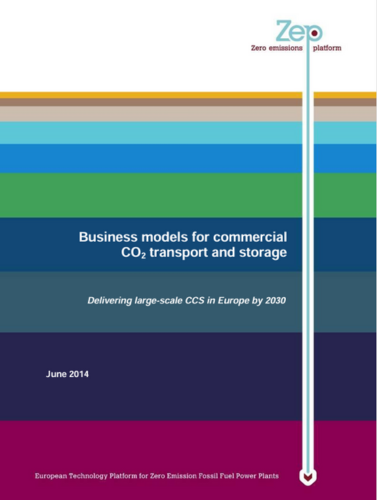Business models for commercial CO2 transport and storage: Delivering large-scale CCS in Europe by 2030
About the report
The critical role of CCS in meeting Europe’s energy, climate and societal goals is now indisputable: the European Commission’s Communication on CCS confirms that it is “vital for meeting greenhouse gas reduction targets”, while the Communication on the 2030 energy and climate framework highlights that CCS “may be the only option available to reduce direct emission from industrial processes at the large scale needed.” As importantly, it will ensure Europe has access to a diverse, reliable, and secure energy supply.
While attention to date has focused on the emitting part of the CCS chain (CO2 capture), large-scale CCS requires CO2 transport and storage infrastructure – at the right time, in the right place, at the right capacity. In the current policy environment, there is no indication this will happen. There is a dearth of companies developing storage sites.
Innovative business models are therefore needed which align commercial interests across the entire CCS chain; and given the long lead times – 6 to 10 years for both pipelines and storage sites – development needs to start now, ahead of wide-scale deployment. Indeed, having a framework in place that enables storage projects to be established with the confidence that then also enables investment in CO2 capture is critical to the timely deployment of CCS in Europe.
The question is: “What is needed to make CO2 transport and storage a viable business?” In order to answer it, ZEP created a dedicated task force of experts representing a broad cross-section of the CCS value chain, including industry, academia, and NGOs. Their conclusions – and solutions – are outlined in this groundbreaking report.
Key conclusions
A policy framework for CO2 transport and storage is critical to deliver EU climate targets
For CO2 Capture and Storage (CCS) to be widely deployed in Europe by 2030, CO2 transport and storage infrastructure must be in place – at the right time, in the right place, at the right capacity. In the current policy environment, however, this is unlikely to happen. Innovative business models are therefore needed which align commercial interests across the entire CCS chain; and given the long lead times – 6 to 10 years for both pipelines and storage sites – development must start now, ahead of wide-scale deployment. A staged roll-out of key hubs is envisaged: initially focused on the North Sea, followed by the Baltic Sea, and ultimately moving onshore and to other EU regions.
Transport and storage operators need market certainty + manageable risk
Business models need to create the market certainty and long-term secured cash flows required for private capital and industry investment. In the currently immature CCS market, this means being able to fund business development costs, capital, operating costs, plus the closure and post-closure phases of
projects. Funding also needs to be flexible and in large enough ‘chunks’ to accelerate the development
of large-scale infrastructure. Finally, as capture, transport and storage are usually independent businesses, minimising counterparty risk for the duration of a storage project (~60 years from beginning to end) is essential. This means decoupling capture businesses from transport and storage.
A risk-reward mechanism is vital to realise storage potential in the timeframe needed
Pre-investment capex for storage exploration and appraisal is incurred 10 years before a capture operator takes final investment decision (FID) – yet can be in the order of €100 million+ (up to a quarter of total storage capex). It must also cover 20 years of post-closure monitoring, when it will be exposed to risk and uncertainty, but without recourse to any balancing income stream. Given the risk of investing in the exploration of storage sites that are ultimately found to be unsuitable – and the fact that time to pay back the investment will be long – a risk-reward mechanism is vital.
Different business models are effective for different phases of CCS development
Three distinct business models have been identified for the three stages of market development:
demonstration, pre-commercial, and mature industry:
- ‘Contractor to the State’ is effective before an established incentive mechanism exists and when
market failure requires state support. Here, state funding is divided into smaller, project-size pieces,
determined on a case-by-case basis. This model has already proved successful for the North Sea
region and will be key to incentivising early movers in other regions. - An ‘Enabled Market’ comprises state support in some parts of the market, managed competition in others. It consists of a regulated entity (the ‘Market Maker’) which removes counterparty risk by a) Managing the development of primary infrastructure on behalf of the state (trunk pipeline + back up storage site) and b) Having a duty to take all captured CO2 and ensure corresponding storage is available. This model is ideal for growing storage volumes during the pre-commercial phase.
- In a ‘Liberalised Market’, private companies develop and manage pipelines, hubs, and storage sites
- without specific state direction. The CCS market is not yet sufficiently mature to move to this model.
This development path is similar to that of other network industries, such as gas and water.
ZEP’s recommendations
- Establish a Market Maker to accelerate the development of key hubs and deliver economies of scale;
- Create a flexible funding mechanism to develop storage and transport infrastructure.
- Establish a liability management mechanism to remove the heavy cost burden from storage operators.
- Support a well-defined and predictable growth trajectory for CO2 capture in national plans.
ZEP recommends a phased approach: in 2014, ZEP to build on these recommendations via an implementation taskforce; in 2015, work to begin on an implementation plan for the North Sea basin hub, in conjunction with Member State governments; from 2016 onwards, the North Sea implementation phase to commence, while work on other regional plans is also underway.
